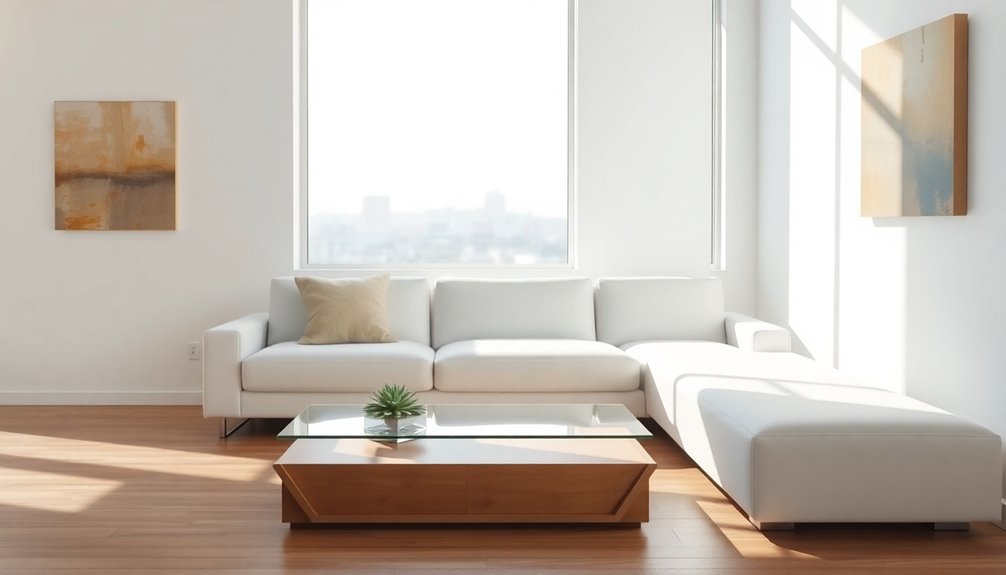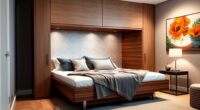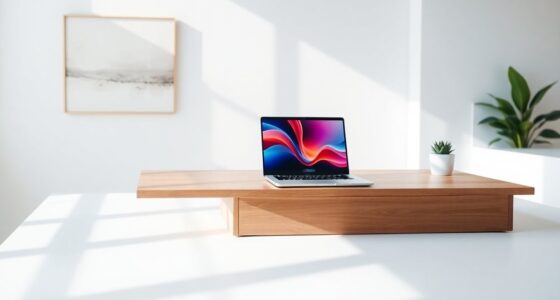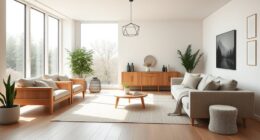In a post-pandemic world, minimalist design helps you adapt to change by promoting calm, functionality, and community connection. Simplified spaces with clean lines and muted colors reduce stress and foster well-being. Flexibility in architecture allows for multipurpose use, meeting diverse needs for work and socialization. By integrating sustainable materials and maximizing natural light, you enhance your environment and mental health. Discover how these elements can transform your spaces and improve your life in meaningful ways.
Key Takeaways
- Minimalist design promotes adaptive spaces, allowing for multifunctionality to accommodate remote work and personal activities post-pandemic.
- Clean lines and muted colors create calming environments that reduce stress and enhance mental well-being in a changed world.
- Incorporating natural materials and biophilic elements fosters a connection to nature, essential for emotional health during uncertain times.
- Flexible outdoor spaces encourage safe socialization, vital for community engagement and mental health recovery after isolation.
- Sustainable materials and quality craftsmanship reflect a commitment to ethical living, resonating with a heightened awareness of environmental impact post-pandemic.
The Essence of Minimalist Design
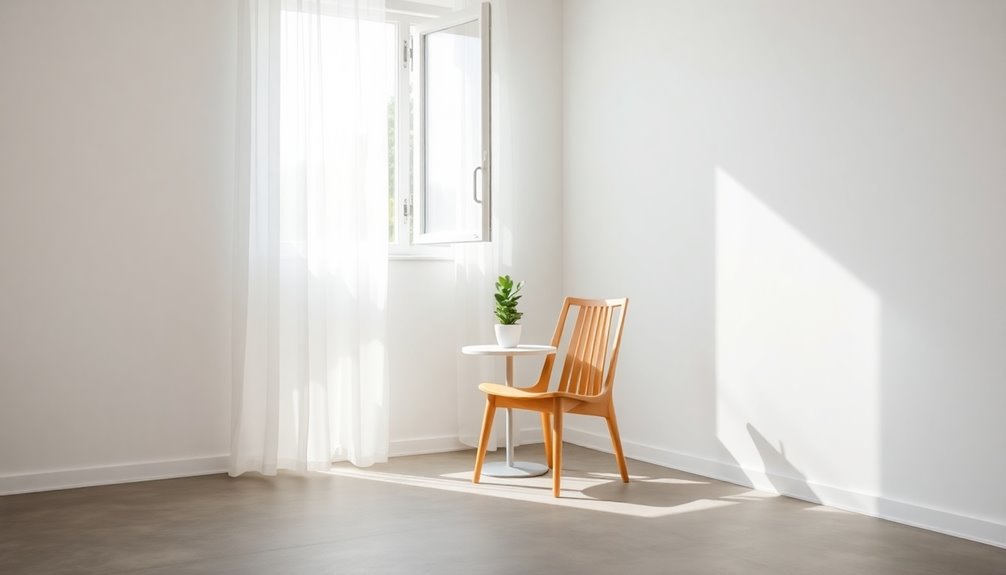
When you think of minimalist design, it's all about embracing simplicity and functionality. This aesthetic focuses on clean lines, monochromatic palettes, and unassuming silhouettes, prioritizing quality over quantity in both fashion and architecture.
It symbolizes a lifestyle choice that emphasizes clarity and sustainability, steering clear of cluttered maximalist trends. Minimalist accessories, like thin hoop earrings and sleek stationery, reflect a commitment to utility and aesthetic appeal, providing significant value without overwhelming you.
High-quality, sustainable fabrics, such as organic cotton and silk, are favored in minimalist fashion, aligning with ethical practices and craftsmanship. This approach transcends borders, influencing global fashion capitals and proving to be a long-lasting design philosophy that remains relevant in today's world. Additionally, sustainability and efficient resource use are key principles that resonate deeply within minimalist design, underscoring its relevance in contemporary architecture and fashion.
Fostering Calm Through Simplified Spaces
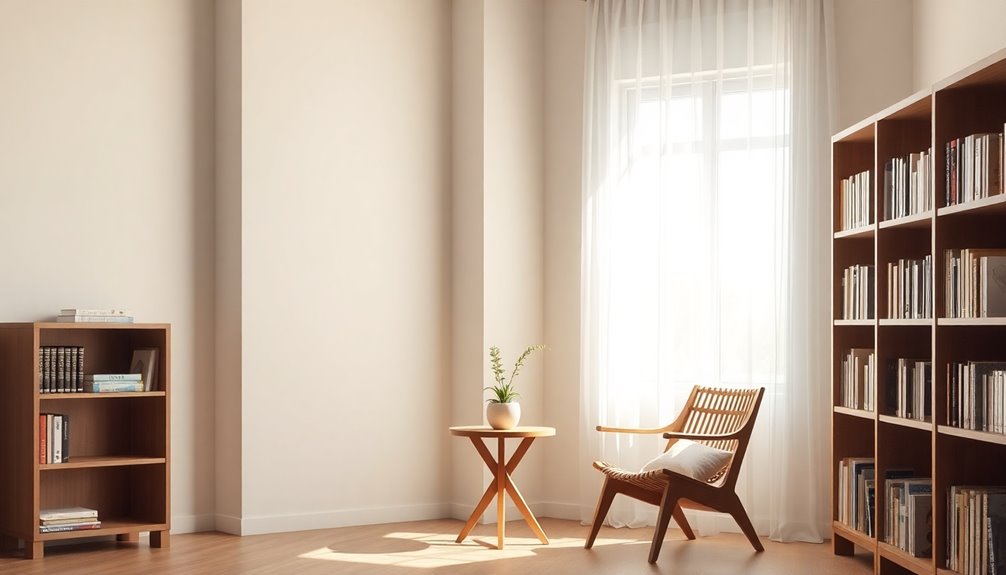
Minimalist design isn't just about aesthetics; it plays a significant role in creating spaces that promote tranquility and focus. By embracing minimalist aesthetics, you can transform your environment into a serene retreat. Consider how the following elements contribute to calm:
| Element | Description | Effect |
|---|---|---|
| Clean Lines | Simple, uncluttered structures | Reduces visual stress |
| Muted Colors | Soft, natural hues | Calms the mind |
| Natural Elements | Incorporating plants and light | Connects you to nature |
| Quality Over Quantity | Fewer, meaningful items | Creates emotional resonance |
| Cost-Effective Solutions | Budget-friendly choices | Fosters a sustainable mindset |
Incorporating natural elements into your home not only enhances aesthetic appeal but also fosters a sense of calm and connection to the outdoors.
Flexibility and Functionality in Architecture
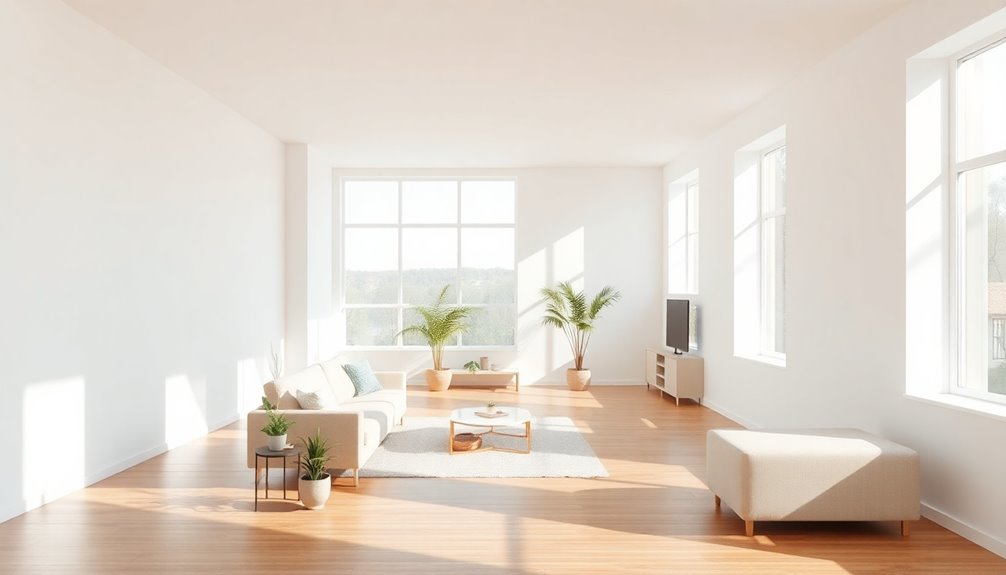
As you explore modern architecture, you'll notice a strong emphasis on adaptive space utilization that meets diverse needs. Multi-functional design elements allow you to transform areas for work, relaxation, or gatherings with ease. Plus, sustainable material choices not only enhance flexibility but also contribute to a healthier environment. Incorporating eco-conscious materials can elevate both the aesthetic and sustainability of your living spaces.
Adaptive Space Utilization
In a world that's constantly evolving, adaptive space utilization in architecture has become essential for meeting diverse needs.
You'll find that modern homes and workplaces now feature multifunctional areas designed to accommodate remote work and educational activities. This shift reflects the new demands on residential environments after the pandemic.
Future architectural plans prioritize adaptable layouts that support social distancing and health preservation, enabling safe interactions in shared spaces. Incorporating movable walls and modular furniture allows for quick reconfiguration in office settings, fostering a dynamic work atmosphere.
Additionally, focusing on outdoor spaces and natural ventilation enhances occupant well-being, emphasizing the importance of creating environments that balance functionality and comfort. Integrating principles from the Law of Attraction can also inspire innovative design solutions that promote positive energy flow within these spaces.
Embrace these changes to enhance your living and working spaces.
Multi-Functional Design Elements
The shift towards adaptive space utilization naturally leads to the rise of multi-functional design elements in architecture.
You'll find these elements prioritize flexibility, allowing spaces to transform easily for various uses, like switching from classrooms to community centers.
In workplaces, elastic office spaces with movable walls and furniture create environments that adjust based on team size and project needs.
Future residential developments are also integrating adaptable layouts, incorporating dedicated workspaces within living areas to accommodate remote work.
Cultural institutions focus on reconfigurable designs, enhancing functionality for different events.
Additionally, the emphasis on health and wellbeing promotes shared yet private spaces, encouraging social interaction while ensuring safety in high-density environments.
Embracing these multi-functional design elements will shape our built environment for the better, as they align with efficient storage strategies that foster organized and peaceful living spaces.
Sustainable Material Choices
While prioritizing flexibility and functionality in architecture, sustainable material choices have become essential in creating spaces that reflect minimalism's core principles. You'll find that high-quality fabrics like organic cotton and silk align with minimalism's quality focus. The rise of recycled materials demonstrates a commitment to ethical practices. With emerging technologies, architects can develop adaptable spaces that enhance both functionality and environmental consciousness. Modular materials promote flexibility, allowing spaces to transform while maintaining a minimalist aesthetic. Additionally, emphasizing natural ventilation and outdoor access not only boosts well-being but also incorporates sustainable materials for a welcoming atmosphere. Incorporating eco-friendly materials can further enhance the design ethos of modern architecture.
| Material Type | Benefits | Applications |
|---|---|---|
| Organic Cotton | Eco-friendly, breathable | Upholstery, curtains |
| Recycled Fabrics | Reduces waste, promotes sustainability | Wall coverings, insulation |
| Silk | Luxurious, durable | Accent pieces, wall art |
| Cashmere | Soft, high-quality | Throws, pillows |
| Modular Materials | Versatile, easy to reconfigure | Furniture, partitioning |
Sustainable Materials for a Healthier Environment
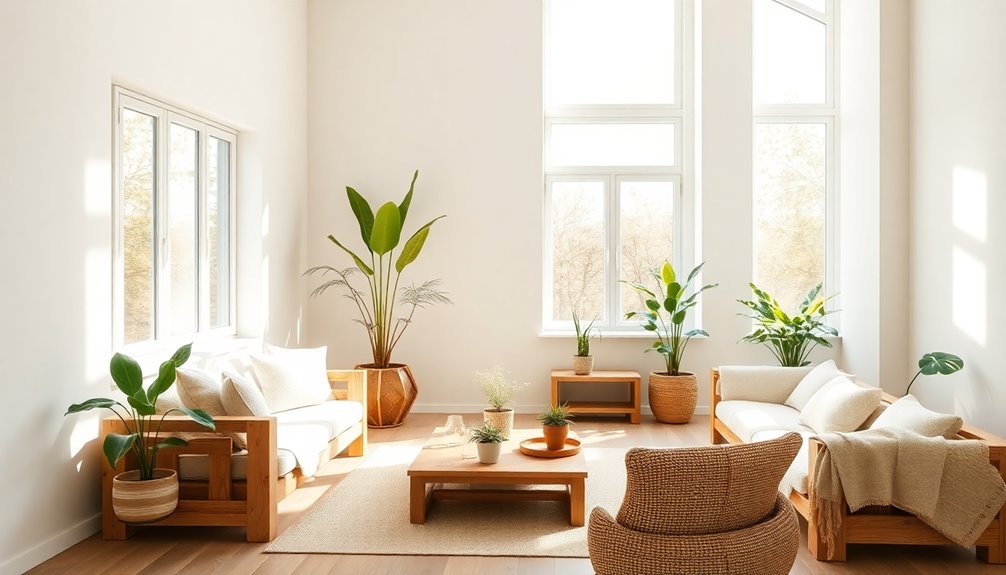
As you explore minimalist design, you'll find that sustainable materials play a crucial role in creating a healthier environment.
High-quality fabrics like organic cotton, linen, and recycled polyester are essential for reducing environmental impact while promoting durability.
Natural materials such as bamboo and cork not only elevate the aesthetic appeal of your spaces but also lower carbon footprints due to their renewability and biodegradability.
Natural materials like bamboo and cork enhance your space's beauty while reducing environmental impact through their renewability and biodegradability.
Designers increasingly incorporate eco-friendly options like Tencel and hemp, reflecting a commitment to sustainable fashion.
Emphasizing timeless elegance, minimalist design encourages you to invest in fewer, higher-quality pieces that last longer and reduce waste.
With advancements in technology, the creation of sustainable materials aligns with ethical practices and maintains a clean, minimalist aesthetic. Additionally, the rise of energy-efficient appliances complements this design philosophy by promoting sustainability in everyday living.
Enhancing Community Connection in Cultural Spaces
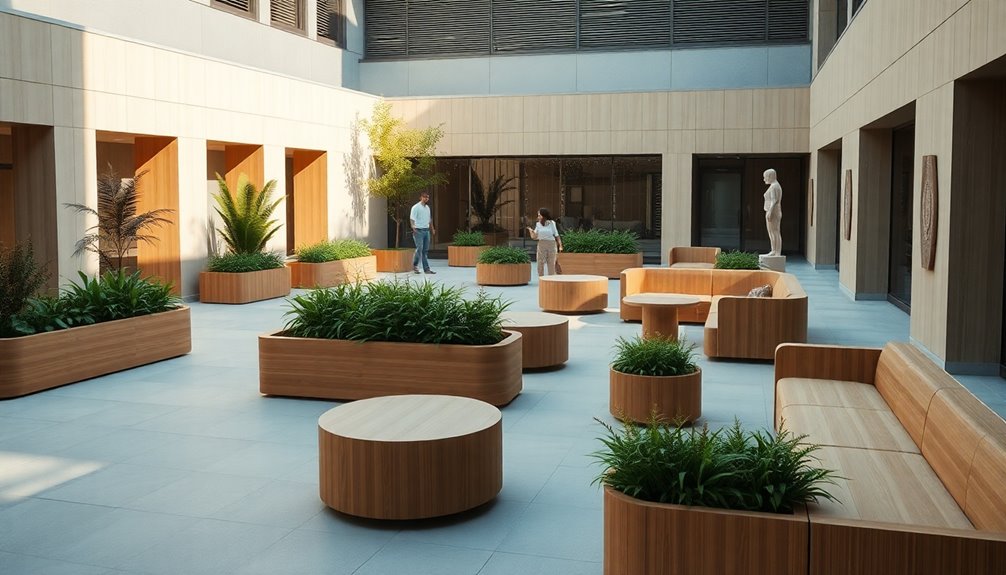
Cultural spaces have transformed considerably in the post-pandemic landscape, prioritizing adaptability to meet the evolving needs of the community.
Here are four ways these spaces enhance community connection:
- Flexible Design: Spaces that can be reconfigured for various events foster diverse interactions.
- Outdoor Spaces: Integrating outdoor areas allows for safe socialization and promotes well-being among visitors.
- Biophilic Elements: Incorporating natural elements creates inviting environments that support mental health, strengthening community ties.
- Technology Integration: Virtual programming broadens access and engagement, reaching diverse community members. Additionally, many spaces are adopting smart home devices to enhance security and connectivity for their users.
The Role of Natural Light in Minimalist Design
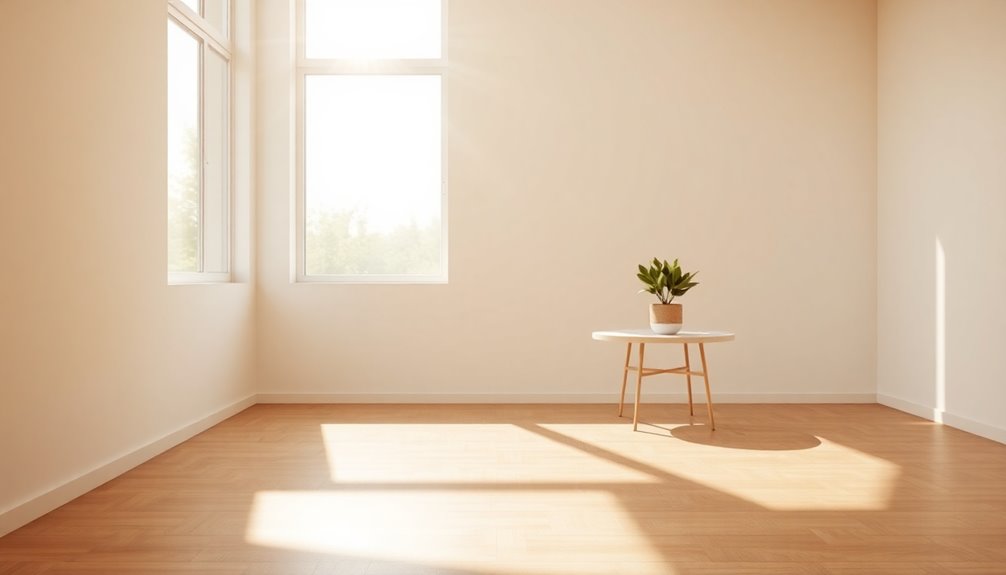
Natural light transforms your minimalist space, enhancing how you perceive its size and openness.
By embracing this element, you not only create a brighter environment but also promote a sense of well-being and tranquility.
You'll find that strategic use of light can elevate the overall ambiance while aligning with the principles of simplicity and clarity. Additionally, incorporating vibrational alignment with your design choices can further enhance the positive energy of your space.
Enhancing Space Perception
- Maximizes openness: Large windows create unobstructed views, blurring the lines between indoors and outdoors.
- Emphasizes simplicity: A monochromatic palette paired with natural light highlights clean lines and unassuming silhouettes.
- Boosts mood: Exposure to natural light improves both mood and productivity, essential for any living or work space.
- Sustainability: Reducing reliance on artificial lighting lowers energy consumption, aligning with the minimalist focus on simplicity. Additionally, incorporating natural elements like whole foods can further enhance the ambiance and health benefits of your space.
Promoting Well-Being
As you embrace minimalist design, you'll find that natural light plays an essential role in promoting well-being. By maximizing daylight, you enhance your space's calmness and clarity, aligning with minimalist principles. Here's how natural light impacts your environment:
| Benefit | Effect on Well-Being | Minimalist Application |
|---|---|---|
| Mood Improvement | Increases happiness | Large windows |
| Productivity Boost | Enhances focus | Open layouts |
| Stress Reduction | Creates a soothing atmosphere | Natural materials |
| Connection to Nature | Fosters mindfulness | Biophilic design principles |
Incorporating natural light creates a seamless indoor-outdoor connection, essential for mental health in a post-pandemic era. Embrace this transformative element to enhance your minimalist space.
Adapting Spaces for Diverse Activities
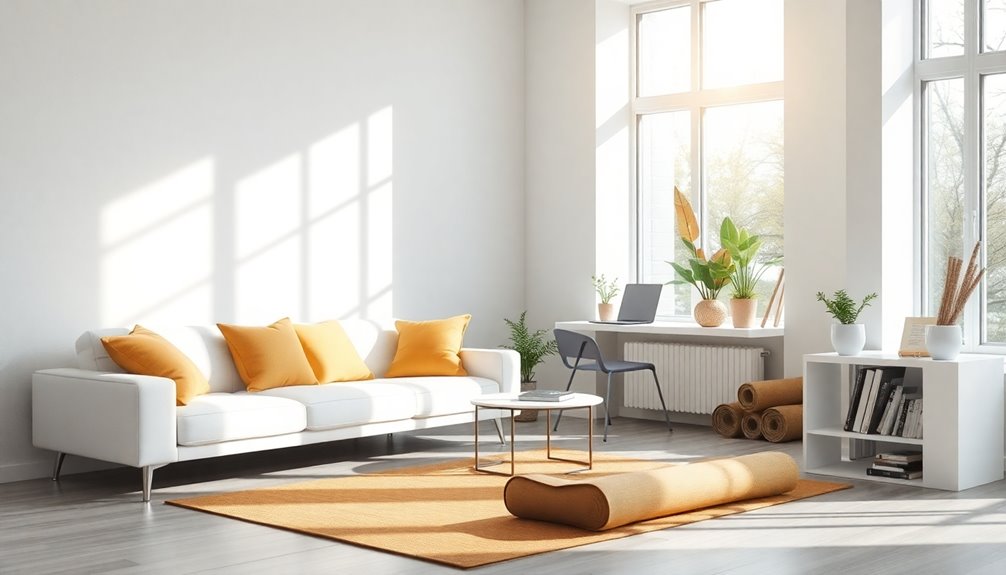
In today's world, where flexibility is key, adapting spaces for diverse activities has become essential.
Here are four ways you can embrace multifunctional design:
- Home Offices: Transform a corner of your living space into a workspace, accommodating both work and leisure.
- Flexible Classrooms: Design classrooms that can easily shift layouts to support various learning styles and social distancing.
- Dynamic Offices: Incorporate movable walls and furniture to adjust workspaces based on team sizes and project needs.
- Public Spaces: Create outdoor venues that cater to both individual and communal activities, enhancing comfort and safety.
Emphasizing Wellbeing and Mental Health
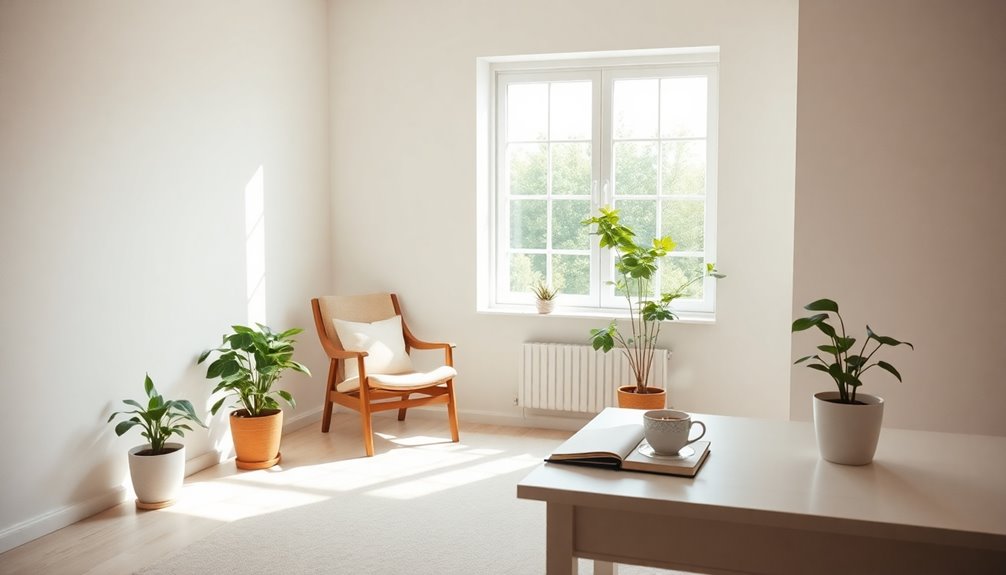
Designing spaces that accommodate diverse activities naturally leads to a focus on wellbeing and mental health.
Minimalist design, with its clean lines and uncluttered spaces, helps reduce stress and enhances your mental clarity. Using muted colors and natural materials can lift your mood and create a calming atmosphere.
Incorporating biophilic elements like plants and natural light connects you to nature, which is essential for reducing anxiety. Furthermore, streamlined environments minimize distractions, boosting your focus and productivity.
This trend toward minimalist living encourages mindfulness, allowing you to be intentional about your surroundings. By fostering a sense of control and clarity in your daily life, you contribute to your overall emotional health and wellbeing.
Future Trends in Minimalist Architecture
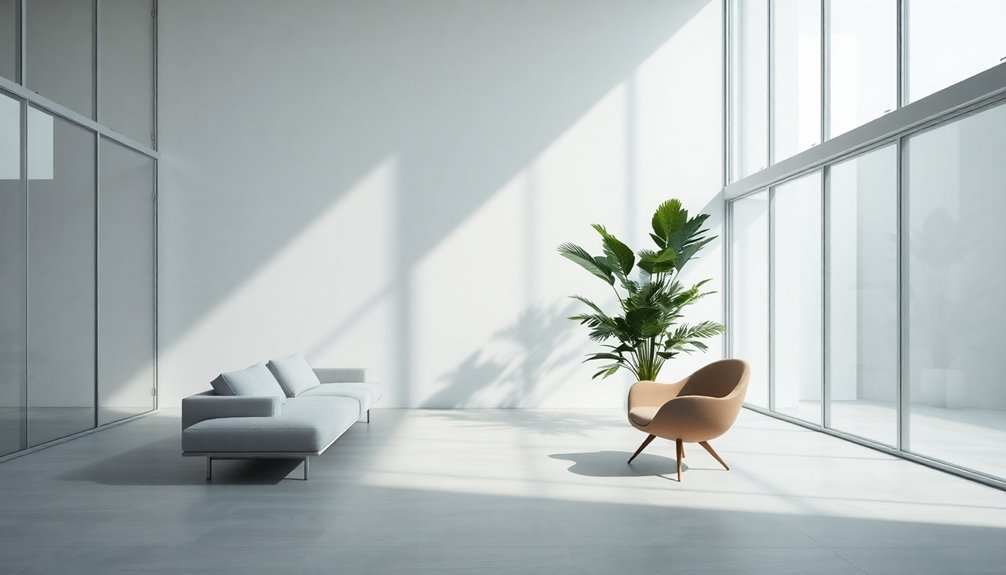
While the world adapts to new norms, future trends in minimalist architecture are emerging to meet evolving needs.
You'll notice that these trends focus on creating spaces that enhance well-being and sustainability:
- Natural light: Designs incorporate large windows and open layouts, promoting a sense of calm.
- Sustainable materials: Eco-friendly choices are prioritized, reflecting the demand for environmentally conscious living.
- Flexible spaces: Multifunctional areas allow for remote work and community gatherings, adapting to your lifestyle.
- Biophilic design: Integrating nature into architecture enhances mental health and quality of life.
These future trends in minimalist architecture emphasize clean lines and interconnected live-work hubs, reducing transportation needs and fostering local engagement.
Embrace these changes for a more harmonious living experience.
Frequently Asked Questions
How Can Minimalist Design Improve Productivity in Workspaces?
Minimalist design can greatly boost your productivity in workspaces by reducing distractions.
When you declutter your environment, you create a more focused atmosphere, allowing you to concentrate on tasks at hand. Simple, clean lines and functional furniture help you navigate your space efficiently.
What Are the Key Principles of Minimalist Interior Design?
Minimalist magic manifests through simple shapes, serene spaces, and subtle colors.
You'll find that key principles include functionality, form, and freedom from clutter.
Prioritize open spaces that promote peace and efficiency.
Focus on fewer, high-quality pieces that enhance your environment rather than overwhelm it.
Embrace neutral palettes with occasional bold accents to create balance.
How Does Minimalist Design Impact User Behavior in Cultural Spaces?
Minimalist design greatly impacts user behavior in cultural spaces by fostering a sense of calm and focus.
When you enter a space that emphasizes simplicity, you're likely to feel less distracted, allowing for deeper engagement with the art or exhibits.
The clean lines and uncluttered environments encourage you to reflect and connect with the content on display.
Ultimately, this approach enhances your experience, making it more memorable and meaningful.
Can Minimalist Design Be Applied to Personal Residences Effectively?
Absolutely, you can apply minimalist design effectively to personal residences.
Imagine transforming a cluttered living room into a serene space with just a sleek sofa, a simple coffee table, and a few carefully chosen decor items.
This approach not only enhances aesthetics but also promotes mental clarity.
By reducing distractions, you're creating an environment that fosters relaxation and focus.
Minimalism encourages you to cherish what truly matters, making your home a sanctuary of peace.
What Challenges Arise When Implementing Minimalist Design in Urban Areas?
When you implement minimalist design in urban areas, you might face challenges like limited space and high costs.
Urban settings often come with cluttered environments, making it tough to achieve that clean, open feel.
You'll also encounter resistance from residents who value personalization and the character of their spaces.
Additionally, finding multifunctional furniture that fits your design can be tricky in a city, which can complicate your minimalist vision.
Conclusion
As you embrace minimalist design in a post-pandemic world, imagine a sunlit room with soft lines and natural materials that invite calm and connection. Picture spaces that flex and adapt, promoting wellbeing and nurturing community ties. With every choice, you're not just creating a home or a workspace; you're crafting a sanctuary that reflects simplicity and purpose. This journey into minimalism isn't just about aesthetics—it's about fostering a healthier, more mindful way of living.
